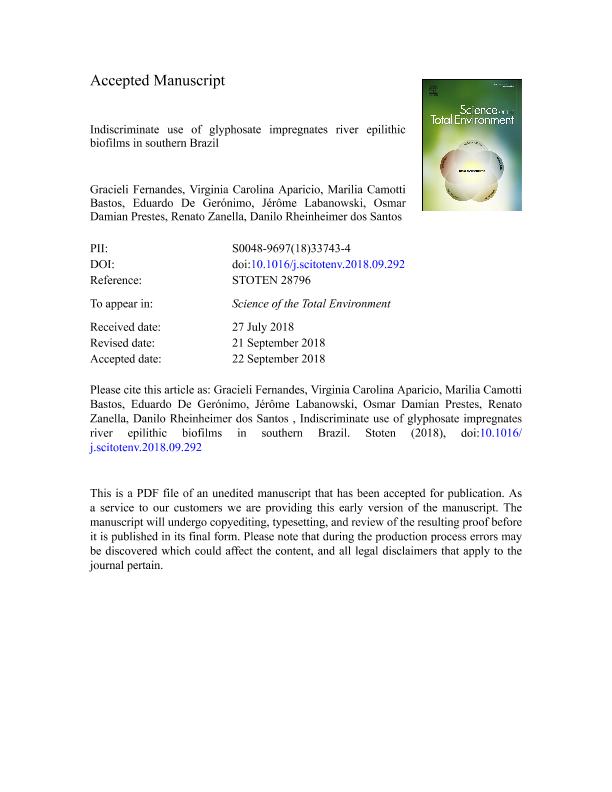Artículo
Indiscriminate use of glyphosate impregnates river epilithic biofilms in southern Brazil
Fernandes, Gracieli; Aparicio, Virginia Carolina ; Bastos, Marilia Camotti; de Gerónimo, Eduardo
; Bastos, Marilia Camotti; de Gerónimo, Eduardo ; Labanowski, Jérôme; Prestes, Osmar Damian; Zanella, Renato; dos Santos, Danilo Rheinheimer
; Labanowski, Jérôme; Prestes, Osmar Damian; Zanella, Renato; dos Santos, Danilo Rheinheimer
 ; Bastos, Marilia Camotti; de Gerónimo, Eduardo
; Bastos, Marilia Camotti; de Gerónimo, Eduardo ; Labanowski, Jérôme; Prestes, Osmar Damian; Zanella, Renato; dos Santos, Danilo Rheinheimer
; Labanowski, Jérôme; Prestes, Osmar Damian; Zanella, Renato; dos Santos, Danilo Rheinheimer
Fecha de publicación:
09/2018
Editorial:
Elsevier Science
Revista:
Science of the Total Environment
ISSN:
0048-9697
Idioma:
Inglés
Tipo de recurso:
Artículo publicado
Clasificación temática:
Resumen
Epilithic biofilms are communities of microorganisms composed mainly of microbial cells, extracellular polymeric substances from the metabolism of microorganisms, and inorganic materials. Biofilms are a useful tool to assess the impact of anthropic action on aquatic environments including the presence of pesticide residues such as glyphosate. The present work seeks to monitor the occurrence of glyphosate and AMPA residues in epilithic biofilms occurring in a watershed. For this, epilithic biofilm samples were collected in the Guaporé River watershed in the fall and spring seasons of 2016 at eight points. Physicochemical properties of the water and biofilms were determined. The determination of glyphosate and AMPA was performed using an ultra-high performance liquid chromatograph coupled to a tandem mass spectrometer. The concentrations of glyphosate and AMPA detected in epilithic biofilms vary with the season (from 90 to 305 μg kg−1 for glyphosate and from 50 to 240 μg kg−1 for AMPA, in fall and spring, respectively) and are strongly influenced by the amount of herbicide applications. Protected locations and those with poor access not demonstrate the presence of these contaminants. In the other seven points of the Guaporé River watershed, glyphosate was detected in concentrations ranging from 10 to 305 μg kg−1, and concentrations of AMPA ranged from 50 to 670 μg kg−1. An overview of the contamination in the Guaporé watershed shows that the most affected areas are located in the Marau sub-watershed, which are strongly influenced by the presence of the city of Marau. This confirms the indiscriminate use of glyphosate in the urban area (weed control, domestic gardens and horticulture) and constitutes a problem for human and animal health. The results showed that biofilms can accumulate glyphosate resulting from the contamination of water courses and are sensitive to the sources of pollution and pesticides present in rivers.
Palabras clave:
Environmental Contamination
,
Glyphosate
,
Ampa
,
Epilithic Biofilms
,
Human Health
Archivos asociados
Licencia
Identificadores
Colecciones
Articulos(CCT - MAR DEL PLATA)
Articulos de CTRO.CIENTIFICO TECNOL.CONICET - MAR DEL PLATA
Articulos de CTRO.CIENTIFICO TECNOL.CONICET - MAR DEL PLATA
Citación
Fernandes, Gracieli; Aparicio, Virginia Carolina; Bastos, Marilia Camotti; de Gerónimo, Eduardo; Labanowski, Jérôme; et al.; Indiscriminate use of glyphosate impregnates river epilithic biofilms in southern Brazil; Elsevier Science; Science of the Total Environment; 651; 9-2018; 1377-1387
Compartir
Altmétricas



